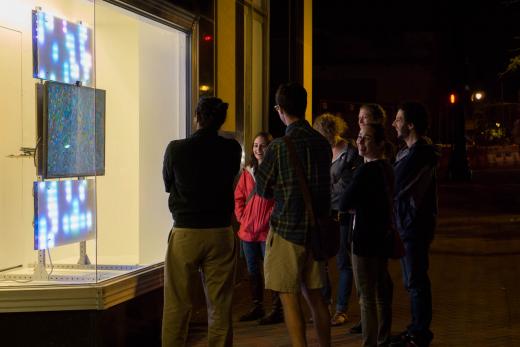- Building a 3D Digital Clock with ArduinoPosted 3 months ago
- Creating a controller for Minecraft with realistic body movements using ArduinoPosted 4 months ago
- Snowflake with ArduinoPosted 4 months ago
- Holographic Christmas TreePosted 4 months ago
- Segstick: Build Your Own Self-Balancing Vehicle in Just 2 Days with ArduinoPosted 5 months ago
- ZSWatch: An Open-Source Smartwatch Project Based on the Zephyr Operating SystemPosted 6 months ago
- What is IoT and which devices to usePosted 6 months ago
- Maker Faire Rome Unveils Thrilling “Padel Smash Future” Pavilion for Sports EnthusiastsPosted 6 months ago
- Make your curtains smartPosted 7 months ago
- Configuring an ESP8266 for Battery PowerPosted 7 months ago
Processing and Arduino to manipulate digital content: easier to become an artist!

When I took a class called “Conducting Robots,” where students were tasked with making a robot, in one semester, that could conduct a ten-piece orchestra, the professors recommended that we use two open source tools: Processing and Arduino. These tools took care of the low-value parts of a project so that we could focus on what mattered: queueing instruments, demonstrating the intensity of the piece, and keeping time for the musicians.
This project was incredibly exciting to me because it demonstrated the freedom that digital art represents. Digital art allows traditional audio and visual methods to take on new forms by adding layers of data and interactivity. This means that your project can respond to events happening in its environment, or on the other side of the world. When a project begins acquiring hardware components like lighting or moving objects, the term digital art seems inadequate since the entire environment becomes the art piece.
Open source dedicated to artists, a new area of interest that many makers are exploring nowadays, thanks to aforementioned tools like:
Processing
Processing is a framework that gives artists a blank canvas on their desktop, and a toolkit for programmatically creating visual art. There is little setup, and a user simply uses two functions to create a program: setup and draw. The setupfunction is called once at the beginning of a program and typically sets up the canvas. Then the draw function is called on a loop until the application finishes running. While simple, it is a powerful way to think about animation. Processing helps make it easy for beginners to create something and provides a framework for creating advanced pieces like installations.
Arduino
What Processing got right for visual art, Arduino expanded for hardware. Instead of technical manuals and complicated development environments, Arduino asks you to implement two functions: setup and loop (sound familiar?). All of the common things that you do with hardware of this size are included in the box: turning things on and off, reading signals from sensors, and talking to other chips all become easy. Arduino can be used to make pure hardware projects, or combined with Processing to make a staggering number of hybrid projects.
And other derived tools like those:
At Smashing Boxes, we have been working on an open source art platform called Fraqture that explores glitch art and manipulating digital content. It uses a Clojure adaptation of Processing called Quil to talk to an Arduino that is driving 540 full-color LEDs. Originally designed to be installed in a storefront window, it sources content using a forward-facing camera and social media.
Source: Opensource.com















